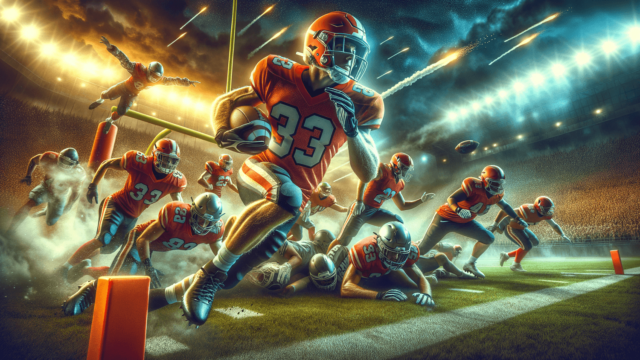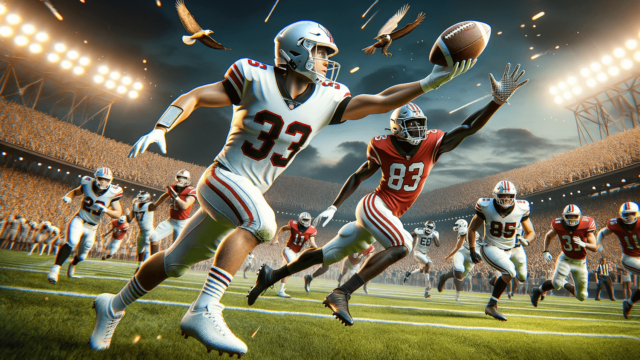
A tight end in football is a versatile player positioned on the offensive line who combines the roles of a blocker and a receiver. They typically line up beside the tackles and are essential in both running and passing plays, contributing to the team’s offensive strategies through their blocking and receiving abilities.
Understanding the Tight End Position
The tight end in football is a hybrid player who can perform multiple roles, making them a valuable asset to any team. This position demands adaptability, as the player must excel in both receiving and blocking, while lining up on the offensive line, usually next to the tackle.
Role of the Tight End in Passing Plays
Receiving Skills
Tight ends are expected to have solid receiving skills as part of their responsibilities. They can be valuable targets for the quarterback, especially in short-to-medium range passes, providing a reliable and efficient option in the passing game. Size, speed, and good hands are essential attributes for tight ends in this aspect of their role.
Route Running
Route running is crucial to the success of a tight end. They need to master specific route patterns designed to exploit gaps and mismatches in the opposing defense. Proper timing, explosiveness, and precise route execution are critical for a tight end to become a dependable target in the passing game.
Role of the Tight End in Running Plays
Blocking Abilities
In running plays, tight ends are responsible for opening up space for running backs. Effective blocking is crucial to create running lanes, and tight ends are expected to block defensive linemen, linebackers, and even safeties, depending on the play’s design. Proper technique, strength, and agility are essential for a tight end to be a good blocker.
Sealing the Edge
One of the crucial assignments tight ends may have in running plays is sealing the edge. They must block defenders on the outside of the formation, creating a path for the running back to gain yardage. Successful tight ends make use of their footwork, leverage, and strength to control their assigned defenders and contribute to the running game.
Physical Attributes of a Tight End
Tight ends tend to possess distinct physical traits that contribute to their success on the field. They are generally tall and muscular, combining both speed and strength to excel in their multiple roles. Their height often ranges from 6’3″ to 6’6″, with a weight between 240 to 260 pounds, giving them an advantage in size and power during games.
Notable Tight Ends in Football
Throughout football history, many exceptional tight ends have left their mark on the sport. These players have showcased exceptional skill, versatility, and ability to adapt to various offensive schemes. Some of the most notable tight ends in football are:
- Tony Gonzalez
- Rob Gronkowski
- Antonio Gates
- Mike Ditka
- Shannon Sharpe
- Kellen Winslow
These tight ends have displayed a unique combination of blocking, receiving, and route-running skills, solidifying their positions among the best to have ever played the sport.
Developing the Skills of a Tight End
Aspiring tight ends must develop essential skills required for the position. This involves improving their route running, catching, and blocking techniques, all of which are integral to their role on the team. Here are a few tips to help players hone their tight end abilities:
Focus on Agility and Speed
Tight ends need to be agile and fast to effectively execute their routes and evade defenders. Practicing agility drills, sprinting exercises, and plyometrics can help increase speed, strength, and balance.
Enhance Receiving Skills
To become a reliable target in the passing game, work on catching drills and hand-eye coordination exercises. Concentrate on high-repetition catching sessions and use various types of balls to challenge and improve catching consistency.
Improve Blocking Techniques
For effective blocking, mastering proper body positioning, footwork, and leverage is essential. Focus on drills that develop hand placement, body alignment, and overall body control when engaging with a defender.
By dedicating time and effort to mastering these skills, aspiring tight ends can enhance their overall performance and contribution to their teams.
FAQ Section: Tight End in Football
Here are some frequently asked questions and answers related to the tight end position in football, providing further insight and addressing common queries about this versatile role:
How do tight ends line up in various offensive formations?
Tight ends can line up in different positions in offensive formations, such as next to the offensive tackle, in the slot, or even as an outside receiver. These various alignments aim to create mismatches and enhance the team’s offensive strategy, exploiting weaknesses in the opposing defense.
What makes a tight end an effective red-zone target?
An effective tight end in the red zone possesses a combination of size, strength, and athleticism. Their height provides a significant advantage in jump ball situations, while their ability to gain separation and position themselves against defenders allows them to be reliable targets in the compressed field near the end zone.
Are there different types of tight ends?
Yes, there are different types of tight ends, generally classified as receiving tight ends and blocking tight ends. Receiving tight ends are potent pass-catchers with advanced route-running skills, while blocking tight ends excel at creating running lanes and sealing the edge. However, the best tight ends have the ability to seamlessly blend both attributes, making them true dual-threats on the field.
What is the main difference between a tight end and a wide receiver?
While both tight ends and wide receivers are essential to a team’s passing attack, the main difference lies in their roles and physical attributes. Tight ends are bulkier and more muscular, primarily tasked with blocking and catching passes in short-to-medium range situations. On the other hand, wide receivers are generally leaner and faster, excelling in deep pass receptions and stretching the field vertically.
How has the tight end position evolved over time?
The tight end position has evolved dramatically in recent years, transforming from primarily a blocking role to a more versatile offensive weapon. Modern tight ends now possess the athleticism and receiving skills typically seen in wide receivers, further expanding their impact on a team’s offensive strategy and forcing defensive coordinators to accommodate their presence during game planning.
Featured Posts
- No pillar pages found.





